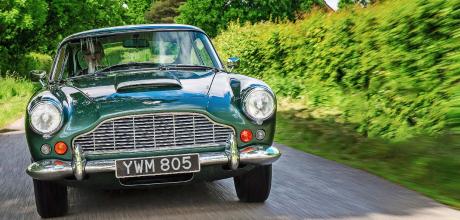1963 Aston Martin DB4 Series 1
Aston Martin fan Mark Palmer was tempted to fill his List with ten of Newport Pagnell’s finest – but honed his desire down to the Aston DB4. Can it deliver on his expectations?
Words ROSS ALKUREISHI
Photography IAN SKELTON
The List Your dream drive made real
Will a lifetime longing for DB4s be sated with a drive?
‘The engine’s pull and the noise are so addictive’
The List Will an Aston Martin DB4 live up to lifelong fan Mark Palmer’s expectations?
No matter how many times you visit purveyor of all things Aston Martin, Surrey-based RS Williams, the same thought always comes to mind, ‘Surely, this is the wrong address?’ That’s the very inclination being conveyed to me by reader Mark Palmer, as I join him in the company’s small but perfectly formed showroom and we savour a select band of the marque’s big hitters – DB5, V8 Volante, DB7 Zagato and his holy grail, the DB4GT Zagato. ‘A bright and breezy street in leafy Cobham seemed a somewhat incongruous spot,’ he ventures. ‘Then I heard the distinctive timbre of a V8 firing up, in what seemed to be the direction of someone’s back garden… forget Porsche, Ferrari, etc – that was the poster supercar of my youth and I would recognise the sound anywhere.’
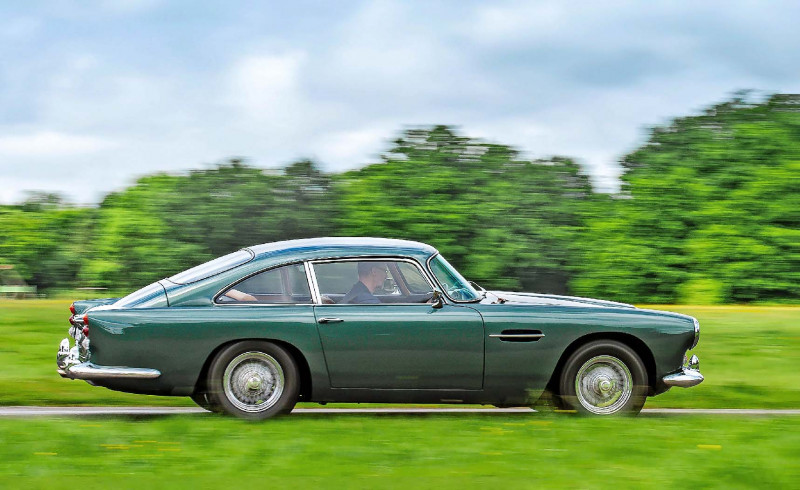
‘Driving that Aston-Martin DB4 – my life is complete’
The siren call of eight cylinders may have lured him into this magical facility nestled deep in suburbia, but we’re foregoing the tumultuous decade that spawned the V8 and instead taking him back to the late Fifties/early Sixties to experience the car that began his Aston Martin infatuation.
‘It’s just stunning,’ he says, as he lays his eyes on a 1962 DB4 resplendent in RSW Green. ‘So, so elegant and complete – nothing is out of place. The line from the headlights through the body to the rear lights, the flat front end (or pointy headlights, depending on your point of view), the curve of the front bumpers. Everything fits together. Seeing it parked there even in this light drizzle, it looks so right and, dare I say it, British.’
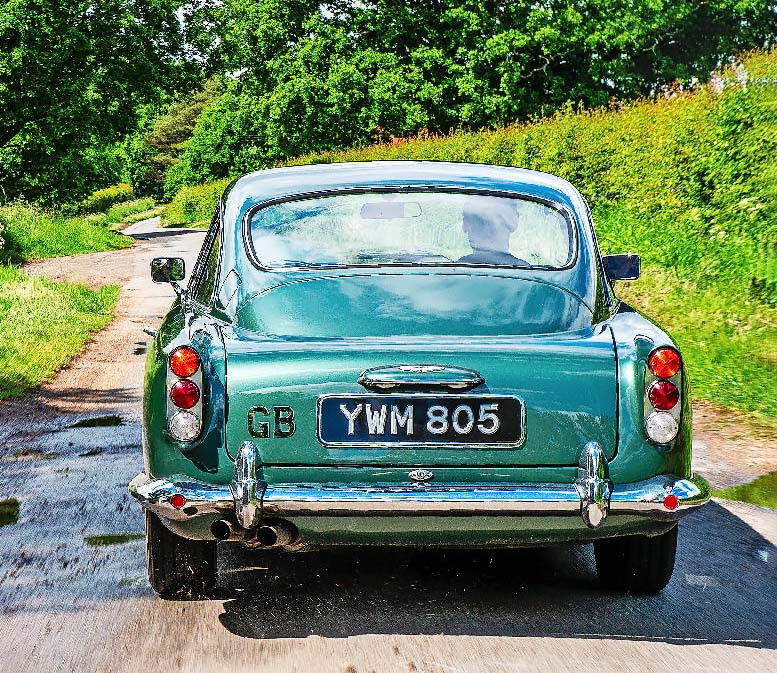
He pops the driver’s door open, revealing a classy cabin finished in an alluring combination of tan hides, dark green carpets and a cream headlining, and slots himself in. ‘I wasn’t expecting this to be quite so big,’ he laughs, gripping the three-spoke wooden steering wheel. ‘It looks like it’s come out of a bus. Compared to it, the tall, thin gear lever looks like a toy. The cabin itself is quite narrow – as expected the doors feel significantly closer than in a modern car. The pedals are slightly offset too – I’m sitting slightly to the right of them.’
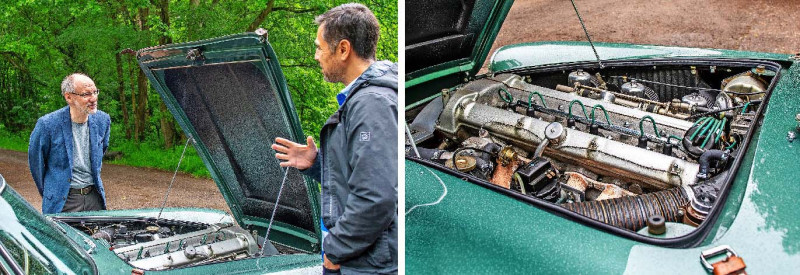
Mark blips the throttle a couple of times and fires up the six-cylinder engine. The cabin is instantly flooded with a deep, resonant sound that hardens sharply under subsequent blips; the only reactions from my driver are a mild lifting of the eyebrows just above his glasses – and two gentle nods of the head, each barely perceptible, but most definitely indicative of pleasure. ‘It sounds absolutely glorious,’ he affirms.
‘It’s just stunning. So elegant and complete. It looks so right and, dare I say it, British’
All new for the DB4, with 240bhp (up from its predecessor’s 160bhp), Tadek Marek’s glorious all-alloy dohc engine propelled the DB range into an altogether loftier performance league. In Vantage guise that rose to 266bhp, with the racing GT and Zagato GT variants both northwards of 300bhp.
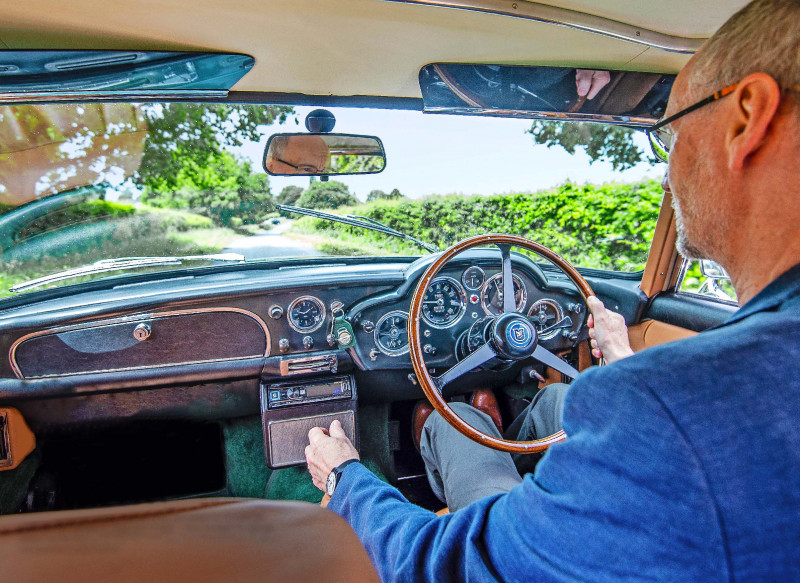
The clutch is engaged with, ‘Oof, that’s heavy’, while engaging first gear elicits, ‘But that’s much better than I expected; it’s tactile and very mechanical in feel. With the tall lever I thought the throw may be longer and the action a bit vague, but it’s not. My Mazda MX-5’s gearbox changes gears with a wrist flick; it’s not quite like that, but again, far better than I expected.’
‘The torque masks the need to make too many gearchanges’
He heads out on to Copse Road and accelerates gently, before engaging second gear and repeating; there’s a pregnant pause as he attempts to select the next ratio, before the revs drop, he waggles the gear lever and tries again. ‘Hmm, finding third is tricky,’ he states with a grunt. ‘The gate is wide and there’s no definable stop.’ He slots into fourth instead and presses the accelerator. ‘The engine is quite happy with that – there’s plenty of torque. That’ll do until I get a bit more practice...’
After a few T-junction manoeuvres, there’s a puzzled look on his brow. ‘I did a classic track day at Mallory Park more than 30 years ago during which I sampled a mildly uprated DB6. Thinking about it, that was a really heavy car to manhandle – the steering on this seems super-light by comparison. I was expecting it to be the opposite.’
I know that RS Williams is renowned for upgrades – and a quick message to Andy back at headquarters confirms that this car is fitted with electric power-assisted steering. Apparently, it’s a common upgrade, one that most owners tend to have.
After a few miles on the A245, we clear Stoke D’Abernon and as the scenery gets properly leafy and free from housing, Mark’s finally able to open the straight-six taps a touch more. ‘Would you listen to that,’ he says, as the intake noise and exhaust note build in unison. ‘This engine is wonderful – the pull and the noise are addictive. However, I am finding that as I go faster, the steering is slightly on the terrifying side; it’s quite vague and because the wheel is so big it really doesn’t seem to do much. The brakes are taking a bit of getting used to as well and need a bit of pushing before anything happens. My old Citroën BX GTi 16v would have had me through the windscreen by now.’
I’m witnessing a strange juxtaposition. Mark’s confidence is building in some respects – engagement of third gear is steadily improving – but not in others, with imperfect road surfaces and the resultant chassis jarring proving a source of unease. We circumnavigate the centre of Leatherhead and park up just south of the town for a quick chat and an opportunity to further admire the car. I ask him the burning question – why a DB4 and not a ’5 or even a ’6? ‘I’m not entirely immune to the James Bond stuff, but for me it has to be the earlier car because it’s the first of the line,’ he replies. With a lot of cars, they get bigger and flabbier. This has that purity of line – I prefer the flat front, rather than the faired-in headlight versions, the smaller bonnet scoop, and those tailfins. It’s one of the most beautiful cars ever made, and green is the classic Aston Martin colour.’
Nipping south, we just touch the northern edge of the Surrey Hills for a bit of B-road blasting. ‘It’s not taken too long to get to grips with the car. I’ve acclimatised to the clutch, and I’m no longer aware of the pedal offset,’ says Mark. He approaches a sharp right-hander, brakes hard, eschewing a downshift and is then hard on the power. ‘I noticed that back there on long straights – and now even here – the torque masks the need to make too many gearchanges. The engine has a lovely flexibility.’ Another sharp corner is dispatched, followed by an immediate S-shift into an even tighter one. ‘Although the steering is dulling the feel somewhat, there’s still enough to garner that these roads aren’t its natural habitat. I was interested to see what the balance is like. With my MX-5, you feel like the car is pivoted around you. Here, the Aston will do the sports car thing; it’s quite solid and planted, but you can really feel the centre of gravity pitching about.’
There’s a perceptible reduction in cornering intensity for the remainder of Mark’s hill work and, as we head north again, he settles into a less frenzied rhythm and offers more thoughts on the cabin. ‘The DB4’s interior doesn’t feel as special as the exterior, but that’s not a criticism; it feels high quality, but without being over the top or silly. I know it’s a cliché, but with the leather upholstery, especially in this colour, it does feel like a gentleman’s club. I like the sober painted metal dashboard and the contrasting chrome-rimmed dials; it’s busy but very business-like. Personally, for me, a DB is all about that wonderful exterior and the driving experience. A smart cabin is simply a bonus.’
So far, today has been dominated by discussions on the merits of technology and as we approach the M25 I’m thankful for it, because a quick check on my phone reveals that it’s flowing. On the slip road Mark goes full fat, unleashing an intoxicating blare in the process. ‘The noise is incredible,’ he states. ‘It’s resonant, without being boomy. And the engine just wants to pull and pull and pull. The suspension is suited to better roads, the ride has smoothed out beautifully. The Aston is in its element now...’
That goes for the driver too. We pass under a bridge, amplifying the exhaust note and there’s nothing barely perceptible about Mark’s facial reaction this time. ‘I’d never tire of that.’ We exit the ‘road to hell’ after a few junctions; the A3 is quickly dispatched with equal relish, and all too soon we’re trundling back along Copse Road and back into RS Williams. As we park up, I’m intrigued to hear Mark’s DB4 conclusion.
Andy joins us just as I pop the bonnet for us to admire the power plant. ‘It has the 4.2-litre upgrade,’ he says. ‘Around 320bhp.’ Another of the company’s famed upgrades. ‘How did you find it?’ he asks. ‘The engine is undoubtedly the star of the show, and the power is just so addictive,’ replies Mark. ‘The steering took the longest to get used to, though. I appreciate why the EPAS system has been fitted; it makes it more usable on a daily basis, but you sacrifice feel. I think personally, I’d keep it as the factory intended. Once I adapted to it though, and explored the car’s handling characteristics, I found that a more relaxed driving approach, rather than trying to hustle it, was better. It’s not an out-and-out sports car, but it is a terrific grand tourer – although maybe it’s a bit noisy for a trip to the south of France. ‘Excluding marriage, births, etc, that’s probably my secondbest experience ever. The first being taking a flight on Concorde.
They say don’t meet your heroes, but it hasn’t disappointed at all. Given the car’s looks I thought it may be delicate, but it’s not at all. It’s robust, remains a true gentleman’s express and has the performance to easily keep up with modern traffic.’
Does it keep its place in his Top 10? ‘Definitely. I purposefully asked for a DB4, rather than a DB4GT or DB4GT Zagato. For me, it’s still one of the most beautiful cars ever made.’
Thanks to RS Williams (rswilliams.co.uk)

A day in the Aston has played second only to a Concorde flight for Mark. Mark and Ross discuss the bored out engine’s 320 rampant horses Discreet upgrades have always been acceptable in the Aston Martin world. Cabin is classy rather than ostentatious.
Steering wheel size proves a distinct surprise for reader Mark. Sober dashboard is actually painted steel
TECHNICAL DATA 1963 Aston Martin DB4 Series 1
- Engine In-line 3670cc six-cylinder, dohc, twin 2in SU carburettors
- Max Power 240bhp @ 5500rpm
- Max Torque 240lb ft @ 4250rpm
- Transmission Four-speed manual, rear-wheel drive
- Steering Rack and pinion
- Suspension Front: independent by wishbones, anti-roll bar, Armstrong telescopic dampers, coil springs Rear: live axle with trailing arms, Watt linkage, Armstrong lever-arm dampers, coil springs
- Brakes Dunlop discs all round, with servo
- Weight 1362kg (3070lb)
- Performance 0-60mph: 8.5sec.
- Top speed: 140mph
- Fuel consumption 15mpg
- Cost new £4084
- Classic Cars Price Guide £500,000


